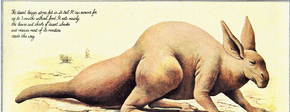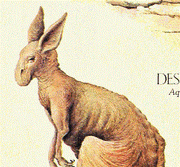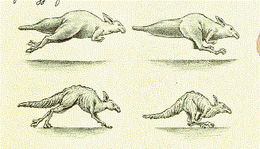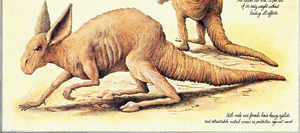
The desert leaper stores fat in its tail. It can survive for up to 3 months without food. It eats mainly the leaves and shoots of desert shrubs and receives most of its moisture needs this way.
The desert leaper, Aquator adepsicautus, is a large, kangaroo-like gerbil from the deserts of Asia and Africa with the lifestyle of a dromedary camel, from After Man: A Zoology of the Future.
The extinction of the dromedary camel at about the same time as humanity died out left a niche that was distinctly unattractive to any other animal. For a large animal to exist in desert conditions a quite remarkable physiology is required. The dromedary camel, for instance, was able to lose about 30 percent of its body weight through dehydration without ill-effects, and it stored all the subcutaneous fat of its body in one lump, leaving the rest of the body free to radiate heat. It could tolerate fluctuations in its body temperature to some extent and had thick nostril covers and eyelids that effectively kept dust and sand out of its nose and eyes
After some 50 million years of evolution these features have all developed again in one Posthomic animal, the desert leaper. The leaper is descended from the sand rat and has grown large (adult males may reach more than 3 meters from nose to tail). The tail is the most unusual feature of this animal; it

The leaper can lose 50 percent of its bodyweight without lasting ill effects.
is here that all its subcutaneous fat is stored. The fat is not a water store, but a store of food that enables the leaper to go for long periods without eating when food is unavailable. When the fat store is full the animal's body is well balanced and it can leap quickly along on its hind limbs. In this condition it can undertake journeys of 100 kilometers or more between waterholes and oases. It has broad, horny pads on the toes of its hind feet which prevent it from sinking into the sand and give it a good grip on naked rock.

When replete with food the desert leaper moves in a series of jumps with its forelimbs folded across its chest. In its emaciated form, it runs in a four-legged fashion.

Both males and females have heavy eyelids and retractable nostril covers as protection against sand.
